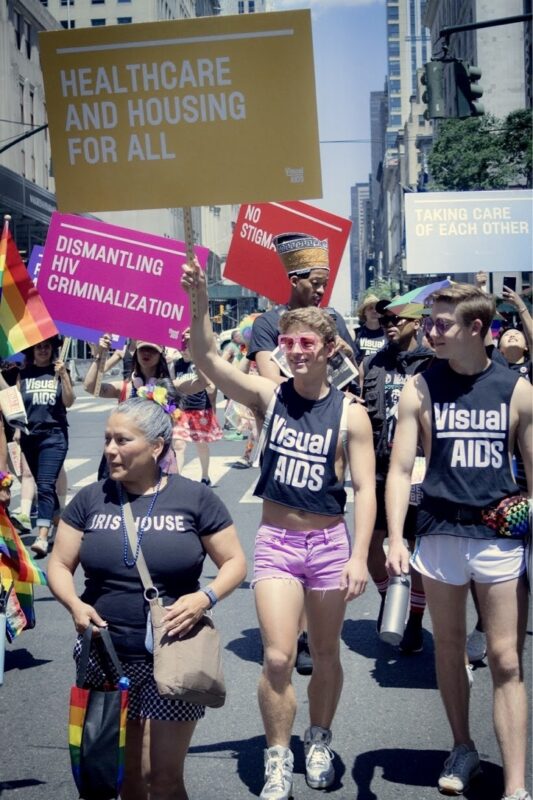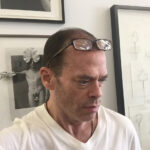This summer, Visual AIDS summer intern Taylor Drake collaborated with Artist Member Eric Rhein to archive and organize his physical and digital materials at Visual AIDS. Taylor's diligence, inquisitive nature, and purposeful research here at Visual AIDS greatly contributed to our ongoing work with the Archive Project. Below, Taylor reflects on his experience working with Visual AIDS and Eric Rhein.
Hi, all! My name is Taylor Drake, and I am a junior at Davidson College. My academic and personal interests surround questions around the power and practice of memory. What do we remember and what do we forget about the past? What societal factors cause collective remembrance among peoples? How do our memories of the past affect us in the present?
I’m especially interested in the phenomenon of post-memory. Coined by Dr. Marianne Hirsch, post-memory refers to the memories passed down from witnesses of an event to generations after them. Hirsch studied post-memory in the context of how Holocaust survivors pass down their memories and trauma of state-sponsored genocide to their families through stories and photographs. Post-memory, however, pertains more to the second, third, fourth generation witnesses of the event and how they understand themselves among these inherited memories and trauma.
This summer, I had the honor of interning with Visual AIDS in their Artist+ Registry and Archive. My work and personal growth with Visual AIDS approached the AIDS epidemic with the notion of post-memory in mind. The Visual AIDS Archive and Artist+ Registry offered constant opportunities for learning and unlearning about life with HIV and the ongoing AIDS epidemic.
My post-memory of the AIDS crisis informed how I viewed my own queer identity and the ongoing HIV and AIDS pandemic. I grew up in Maryville, Tennessee just a shy 45 minutes from Dolly Parton’s hometown (I’ve learned in NYC that 45 minutes is just a “shy” commute). My very religious and conservative upbringing informed my post-memory of the AIDS crisis and how I understood AIDS in the present. My community, church, and the media often portrayed queer identity with endless suffering and death, perpetuating stigma and misinformation about HIV and AIDS. The similar hateful forces that dehumanized my queer elders during the height of the AIDS crisis crystallized my own self-hate and repression of my queer identity.
The art I encountered at Visual AIDS challenged the stigmas, internalized homophobia, and racism tangled in my post-memory of the AIDS crisis. I stopped solely visualizing HIV and AIDS through Therese Fare’s harrowing picture of David Kirby on his deathbed surrounded by mourning family members—a depiction of defeat and devastation to AIDS. He was no longer the singular face of struggle I imagined, and defeat no longer defined my understanding of life with HIV/AIDS.
As part of my internship with Visual AIDS, I worked with Eric Rhein, one of the first ten Artist Members of Visual AIDS, to organize his work and develop a uniform protocol to catalog images and ephemera in the Visual AIDS archive. Eric furthered my growth, expanding my limited post-memory of the crisis and helping me understand the ongoing, lived reality of the pandemic. We became close quite quickly by bonding over our love-hate relationship with the South, our affinity for nature, and inability to organize our desktops. I felt immensely privileged to engage so intimately with his art and listen to the rich stories behind them.
Nearly all of Eric’s artwork is autobiographical, capturing various periods and points in his life with rich, personal details. His series Leaves: An AIDS Memorial honors the life and memory of departed friends by representing them as fallen leaves that Eric has picked up. He evokes their personalities through the form of the leaf, an act of remembrance and resistance to the factors that cause us to historicize and forget the ongoing AIDS pandemic.
His work depicts nature but also embodies its magic. Immortal yet fragile, the stories of past lovers and friends exist as the wind's whisper, a butterfly's gust, a bird's song drifting through a canopy of trees. Eric’s work reminds us that nothing is ever lost in nature, just reborn. The leaves are marks of moments, fossils depicting the energy left behind by their subjects.
The work of Visual AIDS—remembering and combatting the HIV and AIDS pandemic through the practice of archiving—requires a similar approach to picking fallen leaves off the ground. Picking a leaf off the ground acknowledges its fall but also its worth and beauty to be picked up. It is an action of caretaking and love. You must accept the incomprehensible loss portrayed in the work of artists in the Visual AIDS Registry, but also look for the beauty of resilience, life, and love in them. Through fully embracing the lived experiences in their art, we carry on the legacies of those who have been lost. We fight the oppressive forces that stigmatize HIV and AIDS and perpetuate the idea that they are a death sentence. We work against the post-memories and stigmas surrounding HIV and AIDS that tell queer people to hate ourselves. We take pride in our histories and assume urgent responsibility for the well-being of our communities today and tomorrow.
Eric’s work and legacy contributes to the collective community that nurtures and sustains Visual AIDS. And like nature, Visual AIDS’ impact is undefinable and unending. I am forever changed by and grateful for the inimitable people, experiences, and art Visual AIDS exposed to me this summer.



